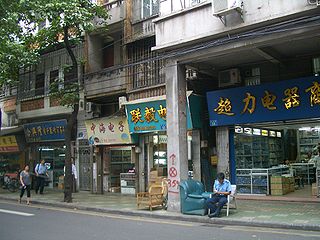Related Research Articles

In commerce, supply chain management (SCM) deals with a system of procurement, operations management, logistics and marketing channels, through which raw materials can be developed into finished products and delivered to their end customers. A more narrow definition of supply chain management is the "design, planning, execution, control, and monitoring of supply chain activities with the objective of creating net value, building a competitive infrastructure, leveraging worldwide logistics, synchronising supply with demand and measuring performance globally". This can include the movement and storage of raw materials, work-in-process inventory, finished goods, and end to end order fulfilment from the point of origin to the point of consumption. Interconnected, interrelated or interlinked networks, channels and node businesses combine in the provision of products and services required by end customers in a supply chain.

A supermarket is a self-service shop offering a wide variety of food, beverages and household products, organized into sections. Strictly speaking, a supermarket is larger and has a wider selection than earlier grocery stores, but is smaller and more limited in the range of merchandise than a hypermarket or big-box market. In everyday American English usage, however, "grocery store" is often casually used as a synonym for "supermarket". The supermarket retail format first appeared around 1930 in the United States as the culmination of almost two decades of retail innovations, and began to spread to other countries after extensive worldwide publicity in 1956.

Retail is the sale of goods and services to consumers, in contrast to wholesaling, which is the sale to business or institutional customers. A retailer purchases goods in large quantities from manufacturers, directly or through a wholesaler, and then sells in smaller quantities to consumers for a profit. Retailers are the final link in the supply chain from producers to consumers.

The point of sale (POS) or point of purchase (POP) is the time and place at which a retail transaction is completed. At the point of sale, the merchant calculates the amount owed by the customer, indicates that amount, may prepare an invoice for the customer, and indicates the options for the customer to make payment. It is also the point at which a customer makes a payment to the merchant in exchange for goods or after provision of a service. After receiving payment, the merchant may issue a receipt, as proof of transaction, which is usually printed but can also be dispensed with or sent electronically.

Distribution is the process of making a product or service available for the consumer or business user who needs it, and a distributor is a business involved in the distribution stage of the value chain. Distribution can be done directly by the producer or service provider or by using indirect channels with distributors or intermediaries. Distribution is one of the four elements of the marketing mix: the other three elements being product, pricing, and promotion.
Discounts and allowances are reductions to a basic price of goods or services.
A value chain is a progression of activities that a business or firm performs in order to deliver goods and services of value to an end customer. The concept comes from the field of business management and was first described by Michael Porter in his 1985 best-seller, Competitive Advantage: Creating and Sustaining Superior Performance.
The idea of [Porter's Value Chain] is based on the process view of organizations, the idea of seeing a manufacturing organization as a system, made up of subsystems each with inputs, transformation processes and outputs. Inputs, transformation processes, and outputs involve the acquisition and consumption of resources – money, labour, materials, equipment, buildings, land, administration and management. How value chain activities are carried out determines costs and affects profits.

Spark New Zealand Limited is a New Zealand telecommunications and digital services company providing fixed-line telephone services, mobile phone services, broadband, and digital technology services. Its customers range from consumers to small - medium business, government agencies and large enterprise clients. It was formerly known as Telecom New Zealand until it was rebranded to Spark on 8 August 2014. It has operated as a publicly traded company since 1990. Spark's mobile network reaches 98% of New Zealand, with over 2.7 million mobile connections and 687,000 broadband connections

Circuit City Corporation, Inc., formerly Circuit City Stores, Inc., is an American consumer electronics retail company, which was founded in 1949 by Samuel Wurtzel as the Wards Company, operated stores across the United States, and pioneered the electronics superstore format in the 1970s. After multiple purchases and a successful run on the NYSE, it changed its name to Circuit City Stores Inc.

Business-to-business is a situation where one business makes a commercial transaction with another. This typically occurs when:

Real Canadian Superstore is a chain of supermarkets owned by Canadian food retailing giant Loblaw Companies. Its name is often shortened to Superstore, or, less commonly, RCSS.

Sprint Corporation was an American telecommunications company. Before being acquired by T-Mobile US on April 1, 2020, it was the fourth-largest mobile network operator in the United States, serving 54.3 million customers as of June 30, 2019. The company also offered wireless voice, messaging, and broadband services through its various subsidiaries under the Boost Mobile and Open Mobile brands and wholesale access to its wireless networks to mobile virtual network operators.
Consignment is a process whereby a person gives permission to another party to take care of their property and retains full ownership of the property until the item is sold to the final buyer. It is generally done during auctions, shipping, goods transfer, or putting something up for sale in a consignment store. The owner of the goods pays the third-party a portion of the sale for facilitating the sale. Consignors maintain the rights to their property until the item is sold or abandoned. Many consignment shops and online consignment platforms have a set time limit at which an item's availability for sale expires. Within the time of contract, reductions of the price are common to promote the sale of the item, but vary by the type of item sold.

Orange UK was a mobile network operator and internet service provider in the United Kingdom, launched in 1994. It was once a constituent of the FTSE 100 Index but was purchased by France Télécom in 2000, which then adopted the Orange brand for all its other mobile communications activities. Orange UK merged with Deutsche Telekom's T-Mobile UK to form a joint venture, EE in 2010. EE continued to operate the Orange brand until February 2015, when new connections and upgrades on Orange tariffs were withdrawn. Existing Orange customers could continue on their plans until March 2019.

Once the strategic plan is in place, retail managers turn to the more managerial aspects of planning. A retail mix is devised for the purpose of coordinating day-to-day tactical decisions. The retail marketing mix typically consists of six broad decision layers including product decisions, place decisions, promotion, price, personnel and presentation. The retail mix is loosely based on the marketing mix, but has been expanded and modified in line with the unique needs of the retail context. A number of scholars have argued for an expanded marketing, mix with the inclusion of two new Ps, namely, Personnel and Presentation since these contribute to the customer's unique retail experience and are the principal basis for retail differentiation. Yet other scholars argue that the Retail Format should be included. The modified retail marketing mix that is most commonly cited in textbooks is often called the 6 Ps of retailing.

Colocation is the act of placing multiple entities within a single location.

In a supply chain, a vendor, supplier, provider or a seller, is an enterprise that contributes goods or services. Generally, a supply chain vendor manufactures inventory/stock items and sells them to the next link in the chain. Today, these terms refer to a supplier of any goods or service. In property sales, the vendor is the name given to the seller of the property.
Network equipment providers (NEPs) – sometimes called telecommunications equipment manufacturers (TEMs) – sell products and services to communication service providers such as fixed or mobile operators as well as to enterprise customers. NEP technology allows for calls on mobile phones, Internet surfing, joining a conference calls, or watching video on demand through IPTV (internet protocol TV). The history of the NEPs goes back to the mid-19th century when the first telegraph networks were set up. Some of these players still exist today.
Customer experience, sometimes abbreviated to CX, is the totality of cognitive, affective, sensory, and behavioral customer responses during all stages of the consumption process including pre-purchase, consumption, and post-purchase stages.
The retail format influences the consumer's store choice and addresses the consumer's expectations. At its most basic level, a retail format is a simple marketplace, that is; a location where goods and services are exchanged. In some parts of the world, the retail sector is still dominated by small family-run stores, but large retail chains are increasingly dominating the sector, because they can exert considerable buying power and pass on the savings in the form of lower prices. Many of these large retail chains also produce their own private labels which compete alongside manufacturer brands. Considerable consolidation of retail stores has changed the retail landscape, transferring power away from wholesalers and into the hands of the large retail chains.
References
- Slywotzky, A.; et al. (1999). "Mega Patterns: Effecting Multiple Industries for Extended Times". Business eSolutions. Retrieved 2006-06-20.
- InterTradeIsland (2002). "All Island Competitiveness: Information & Communications Technology" (PDF). InterTradeIreland Trade and Business Development Body. Archived from the original (PDF) on 2006-03-20. Retrieved 2006-06-20.
- Trowbridge, D.; et al. (2004). "Integration Patterns". MSDN Library. Retrieved 2006-06-20.
- Shankar, B. (2003). "The Value of Convergence". ITU Telecom World. Retrieved 2006-06-20.